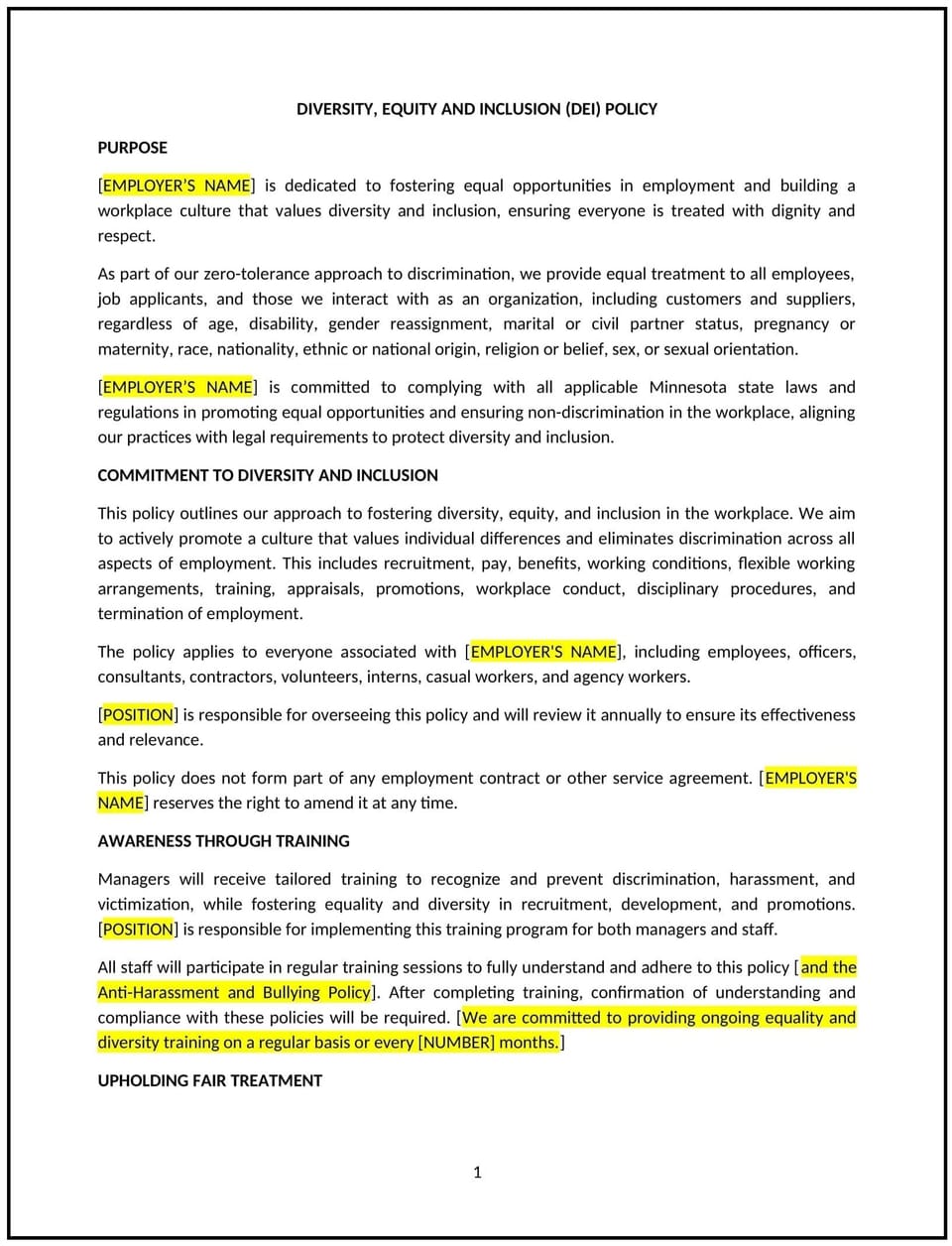Diversity, equity, and inclusion (DEI) policy (Minnesota): Free template

Diversity, equity, and inclusion (DEI) policy (Minnesota)
This diversity, equity, and inclusion (DEI) policy is designed to help Minnesota businesses create a workplace culture that values and promotes diversity, equity, and inclusion. It outlines the company’s commitment to fostering an environment where all employees feel respected, valued, and supported, regardless of their race, gender, age, religion, disability, or other characteristic.
By implementing this policy, businesses can build a more inclusive workforce, enhance employee engagement, and contribute to a more positive and productive work environment.
How to use this DEI policy (Minnesota)
- Define diversity, equity, and inclusion: Clearly explain what diversity, equity, and inclusion mean within the context of the company and how they contribute to the overall work culture.
- Set clear objectives: Outline specific goals for achieving diversity, equity, and inclusion, such as increasing workforce diversity, ensuring equal opportunities for all employees, and promoting inclusive leadership.
- Establish recruitment practices: Detail how the company will ensure a diverse candidate pool, including partnerships with diverse organizations, outreach to underrepresented groups, and inclusive hiring practices.
- Provide training and development: Offer regular DEI training for employees at all levels to raise awareness about unconscious bias, microaggressions, and strategies for fostering an inclusive environment.
- Encourage open dialogue: Foster a culture where employees can openly discuss DEI issues, provide feedback, and raise concerns in a safe and respectful manner.
- Create accountability mechanisms: Establish metrics for measuring DEI progress and hold managers and leaders accountable for creating an inclusive culture.
Benefits of using a DEI policy (Minnesota)
Implementing this policy provides several advantages for Minnesota businesses:
- Enhances employee engagement: A diverse and inclusive workplace improves morale, job satisfaction, and overall employee well-being.
- Boosts innovation: Diverse teams bring a variety of perspectives, which can lead to more innovative solutions and improved business outcomes.
- Reduces turnover: Employees are more likely to stay with a company that promotes fairness and inclusion, reducing recruitment and training costs.
- Reflects Minnesota’s values: Aligns the business with Minnesota’s commitment to diversity, equity, and inclusion, promoting social responsibility and community involvement.
- Promotes a positive reputation: Demonstrates to customers, clients, and the broader community that the business values diversity and is committed to providing equal opportunities for all.
Tips for using this DEI policy (Minnesota)
- Communicate clearly: Make sure all employees understand the company’s DEI goals, initiatives, and how they can contribute to creating an inclusive workplace.
- Provide leadership commitment: Ensure that leadership is actively involved in promoting and supporting DEI efforts through communication, actions, and role modeling inclusive behavior.
- Measure progress: Regularly assess DEI metrics and adjust programs as necessary to achieve the desired outcomes, such as improving diversity in hiring or increasing employee satisfaction with inclusion efforts.
- Encourage employee involvement: Provide opportunities for employees to participate in DEI initiatives, such as employee resource groups, mentorship programs, and volunteer activities in the community.
- Update regularly: Review and update the DEI policy periodically to ensure it remains relevant to the business and reflects changes in state or federal laws, as well as evolving societal expectations.
Q: What does diversity, equity, and inclusion (DEI) mean in this policy?
A: Businesses should define diversity as the presence of differences in the workforce, equity as ensuring fair treatment and equal access to opportunities, and inclusion as creating an environment where all employees feel valued and respected.
Q: How does the company promote diversity in recruitment?
A: Businesses should implement inclusive recruitment strategies, such as broadening candidate sourcing, using blind recruitment processes, and partnering with organizations that focus on diversity.
Q: What types of DEI training should be offered to employees?
A: Employees should receive training on topics such as unconscious bias, cultural competency, conflict resolution, and promoting inclusive behavior in the workplace.
Q: How can employees contribute to creating an inclusive environment?
A: Employees should be encouraged to engage in DEI initiatives, actively participate in training sessions, and demonstrate inclusive behaviors by respecting diverse perspectives and supporting colleagues from all backgrounds.
Q: What is the role of leadership in DEI?
A: Leadership should model inclusive behaviors, communicate the importance of diversity, equity, and inclusion, and hold themselves and others accountable for creating an inclusive workplace culture.
Q: How will progress on DEI initiatives be measured?
A: Businesses should establish measurable goals, track metrics such as diversity in hiring, employee retention, and satisfaction, and assess the effectiveness of DEI programs through employee feedback and surveys.
Q: How often should this policy be reviewed?
A: The policy should be reviewed annually to assess progress, incorporate feedback from employees, and ensure it reflects any changes in state or federal DEI laws, business practices, or societal shifts.
This article contains general legal information and does not contain legal advice. Cobrief is not a law firm or a substitute for an attorney or law firm. The law is complex and changes often. For legal advice, please ask a lawyer.


